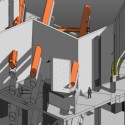 I am constantly amazed at how the world of litigation has changed so much in such a short period of time since I started practicing almost 20 years ago. OK, I accept that some of you don’t think 20 years is a short period of time, but it sure seems like it to me. As I have mentioned in this blog before, the ability to make powerful, high-quality trial graphics was extremely limited by the software available in the early 1990s. I was reminded of how far we’ve come in the area of visualization and modeling when I recently had dinner with Mike McTeer, who made a similar career shift as I did, but in a different field. Mike has a background in construction, and a few years ago, he decided to start a firm that specializes in 3D visualizations of construction.
I am constantly amazed at how the world of litigation has changed so much in such a short period of time since I started practicing almost 20 years ago. OK, I accept that some of you don’t think 20 years is a short period of time, but it sure seems like it to me. As I have mentioned in this blog before, the ability to make powerful, high-quality trial graphics was extremely limited by the software available in the early 1990s. I was reminded of how far we’ve come in the area of visualization and modeling when I recently had dinner with Mike McTeer, who made a similar career shift as I did, but in a different field. Mike has a background in construction, and a few years ago, he decided to start a firm that specializes in 3D visualizations of construction.
His firm specializes in “Construction Visualization Integration and Building Information Modeling,” which basically means he visualizes and creates models of projects so builders more fully understand the process of the project, discover better ways to build it, and identify problems before they occur. When I saw his work, I was struck by what a great tool this is for the construction industry. This type of computer modeling was impossible only a few years ago, and Mike says that a number of larger clients now require it for any job before the work starts.
You might ask, what does this have to do with litigation? Well, just like Mike’s clients who never used this process before then realized they cannot do a project without it, attorneys who discover how a case can be visualized and strengthened with graphics at an early stage begin to view litigation graphics as a de facto requirement for case preparation and presentation.
One of Mike’s recent projects provided a great example of how this type of visualization can be vital to a safe work site by showing hazards and errors ahead of time so they can be resolved.
With the 3D modeling capability that is possible now, Mike can create all the models of a crane with the proper length, angles and swings. Therefore, he can determine the lifting capacity at any given location and the exact specifications that will be needed at any point, and see if hazards exist to the workers or the equipment.
In another example, Mike visualized the entire process of installing the temporary shoring on a project, so that all problems could be identified ahead of time.
One of the things I have learned over the years is that to draw something, you have to really understand it. When you have detailed scaled drawings and/or 3D models done for a case early on, you often identify issues that you never would have considered without those visual aids.
For example, seeing a 3D model allows you to see what any person would have seen from their vantage point, and the model can be used in deposition to help cross-examine witnesses. Also, preparing an animation of a process of construction or failure often exposes subtle weaknesses in your theory when it has to be explained in a such precise visual detail.
By developing graphics early in a case, and working on them throughout the litigation, attorneys can avoid major problems, just as construction companies can avoid injuries and costly errors in their work by creating these drawings and models in advance. By developing graphics for mediation and trial, you can help the mediator or jury see your point and understand the case much better.
If you’d like to learn how Cogent Legal can help you with your litigation graphic needs—and help you early on to avoid problems in litigation later—please contact me.
If you’d like to receive updates from this blog, please click to subscribe by email.


.png)
.png)